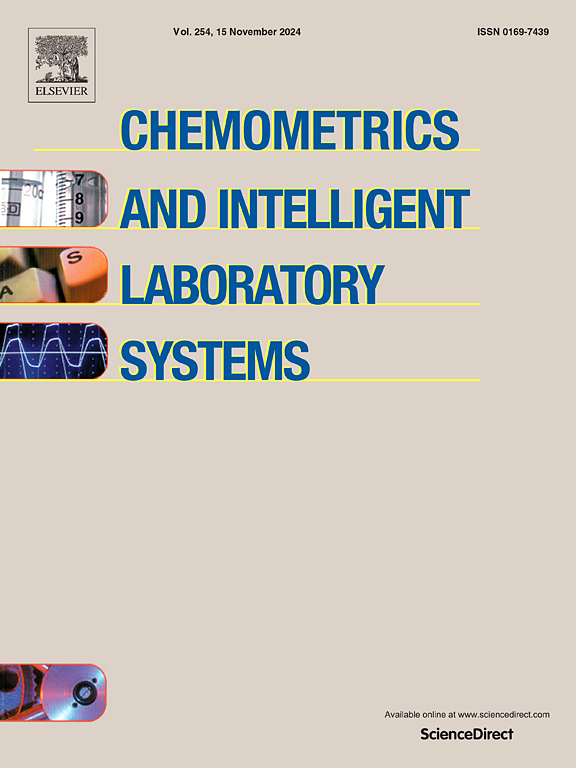A sensitive efficient multiple predictable feature extraction and fusion method for complicated industrial fault detection
IF 3.8
2区 化学
Q2 AUTOMATION & CONTROL SYSTEMS
Chemometrics and Intelligent Laboratory Systems
Pub Date : 2025-05-06
DOI:10.1016/j.chemolab.2025.105423
引用次数: 0
Abstract
In recent years, graph-based predictable feature analysis (GPFA) has emerged as a potential tool in industrial fault diagnosis. However, the basic GPFA can only extract the linear predictable feature information, which is incompetent in the scenarios of the complicated linear-nonlinear hybrid data characteristic. To handle this issue, an improved fault detection method, called Sensitive Efficient Multiple Graph-based Predictable Feature Analysis (SEM-GPFA), is presented for mining the linear and nonlinear predictable features simultaneously. In this method, a multiple predictable feature fusion framework is constructed to utilize the complementary advantages of linear and nonlinear features fully. The linear predictable features are extracted by the basic GPFA, while the nonlinear predictable features are captured by the nonlinear GPFA model. To address the high computational complexity of traditional kernel methods, a random Fourier mapping method is used to improve the nonlinear feature extraction approach, enhancing operational efficiency. Considering that the specific fault information may be concealed in massive features of the model, a fault-sensitive feature highlighting strategy is designed by assigning relatively large weights to emphasize the influence of significant fault features. Finally, case studies on the Continuously Stirred Tank Reactor (CSTR) process and the Tennessee Eastman (TE) chemical system are conducted to demonstrate the superiority of the proposed method.
复杂工业故障检测中一种灵敏、高效的多可预测特征提取与融合方法
近年来,基于图的可预测特征分析(GPFA)已成为一种潜在的工业故障诊断工具。然而,基本的GPFA算法只能提取线性可预测的特征信息,在复杂的线性-非线性混合数据特征场景下,这种算法是不适用的。为了解决这一问题,提出了一种改进的故障检测方法,即基于敏感高效多图的可预测特征分析(SEM-GPFA),用于同时挖掘线性和非线性可预测特征。该方法构造了一个多可预测特征融合框架,充分利用了线性特征和非线性特征的互补优势。线性可预测特征由基本GPFA提取,非线性可预测特征由非线性GPFA模型捕获。针对传统核方法计算量大的问题,采用随机傅里叶映射方法对非线性特征提取方法进行改进,提高了运算效率。考虑到特定的故障信息可能隐藏在模型的大量特征中,设计了一种故障敏感特征突出策略,通过分配较大的权重来强调重要故障特征的影响。最后,以连续搅拌槽式反应器(CSTR)工艺和田纳西伊士曼(TE)化工系统为例,验证了该方法的优越性。
本文章由计算机程序翻译,如有差异,请以英文原文为准。
求助全文
约1分钟内获得全文
求助全文
来源期刊
CiteScore
7.50
自引率
7.70%
发文量
169
审稿时长
3.4 months
期刊介绍:
Chemometrics and Intelligent Laboratory Systems publishes original research papers, short communications, reviews, tutorials and Original Software Publications reporting on development of novel statistical, mathematical, or computer techniques in Chemistry and related disciplines.
Chemometrics is the chemical discipline that uses mathematical and statistical methods to design or select optimal procedures and experiments, and to provide maximum chemical information by analysing chemical data.
The journal deals with the following topics:
1) Development of new statistical, mathematical and chemometrical methods for Chemistry and related fields (Environmental Chemistry, Biochemistry, Toxicology, System Biology, -Omics, etc.)
2) Novel applications of chemometrics to all branches of Chemistry and related fields (typical domains of interest are: process data analysis, experimental design, data mining, signal processing, supervised modelling, decision making, robust statistics, mixture analysis, multivariate calibration etc.) Routine applications of established chemometrical techniques will not be considered.
3) Development of new software that provides novel tools or truly advances the use of chemometrical methods.
4) Well characterized data sets to test performance for the new methods and software.
The journal complies with International Committee of Medical Journal Editors'' Uniform requirements for manuscripts.

 求助内容:
求助内容: 应助结果提醒方式:
应助结果提醒方式:


